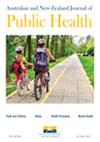Examining zoonotic notifications in Aboriginal and Torres Strait Islander populations over time: An analysis of the National Notifiable Diseases Surveillance System from 1996-2021
IF 2.4
3区 医学
Q2 PUBLIC, ENVIRONMENTAL & OCCUPATIONAL HEALTH
Australian and New Zealand Journal of Public Health
Pub Date : 2025-04-21
DOI:10.1016/j.anzjph.2025.100239
引用次数: 0
Abstract
Objective
This paper utilised the National Notifiable Diseases Surveillance System database to analyse the commonly notified zoonotic disease presentations in Aboriginal and Torres Strait Islander populations over 25 years, from 1996-2021.
Methods
We analysed the top four zoonotic notifications using a descriptive analysis, a time series analysis assessing the trends and seasonal indices, and a de-seasonalised analysis to assess the years contributing to an increase above the trend.
Results
Results show an increase in notifications for salmonellosis and campylobacteriosis over the last 10 years. On average, all diseases saw an increase in notifications above the trend in Q1 (Jan-Mar) and less so Q2 (Apr-Jun), and a decrease in notifications below the trend in Q3 (Jul-Sep) and less so in Q4 (Oct-Dec), which is aligned with increases in zoonotic notifications in Australia’s hotter and wetter months.
Conclusion
The results present zoonotic notifications in Aboriginal and Torres Strait Islander populations over time and highlight potential implications of climate change due to increasing notifications, and increasing temperatures and extreme weather events in recent years.
Implications for public health
The findings can inform preventative health approaches for zoonoses in Indigenous populations, with One Health approaches recommended.
审查土著和托雷斯海峡岛民人口的人畜共患病报告:1996-2021年国家法定疾病监测系统的分析
目的利用国家法定传染病监测系统数据库,分析1996-2021年25年间原住民和托雷斯海峡岛民人群中常见的人畜共患病报告。方法采用描述性分析、评估趋势和季节指数的时间序列分析以及非季节性分析来评估导致趋势以上增长的年份,对排名前4位的人畜共患病通报进行了分析。结果显示,在过去10年中,沙门氏菌病和弯曲杆菌病的通报有所增加。平均而言,所有疾病的通报量在第一季度(1 - 3月)高于趋势,第二季度(4 - 6月)低于趋势,第三季度(7 - 9月)低于趋势,第四季度(10 - 12月)低于趋势,这与澳大利亚炎热潮湿月份人畜共患病通报量的增加相一致。结论研究结果揭示了近年来土著人和托雷斯海峡岛民人畜共患病通报情况的变化趋势,并强调了气候变化、气温升高和极端天气事件的潜在影响。研究结果可为土著人群人畜共患病的预防性卫生措施提供信息,建议采用“同一个健康”方法。
本文章由计算机程序翻译,如有差异,请以英文原文为准。
求助全文
约1分钟内获得全文
求助全文
来源期刊

Australian and New Zealand Journal of Public Health
医学-公共卫生、环境卫生与职业卫生
CiteScore
4.20
自引率
5.70%
发文量
121
审稿时长
6-12 weeks
期刊介绍:
The Australian and New Zealand Journal of Public Health (ANZJPH) is concerned with public health issues. The research reported includes formal epidemiological inquiries into the correlates and causes of diseases and health-related behaviour, analyses of public policy affecting health and disease, and detailed studies of the cultures and social structures within which health and illness exist. The Journal is multidisciplinary and aims to publish methodologically sound research from any of the academic disciplines that constitute public health.
 求助内容:
求助内容: 应助结果提醒方式:
应助结果提醒方式:


